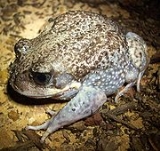
Heleioporus
Encyclopedia
Heleioporus is a genus of frogs native to Australia
. Of the six species in this genus, five live in south-west Western Australia
, while the other one species only occurs in south-eastern Australia. All members of this genus are medium to large sized burrowing frogs with rounded heads, short bodies, bulging eyes, short limbs and the hands are free from webbing. The toes are relatively short with only a trace of fleshy webbing. A characteristic of this genus (except for Heleioporus eyrei and some Heleioporus psammophilus) is the black nuptial spines that male frogs have on their first and occasionally second and third fingers. The pupil restrict to form a vertical slit and the tympanum is usually distinct. All the species in this genus call from burrows where the eggs are later deposited in a foam mass. Embryos develop in this mass until hatching. Hatching occurs after the burrows are flooded with water, and may be delayed until this happens. The calls of these species are similar although differ in frequency, length, note and repetition rate.
Australia
Australia , officially the Commonwealth of Australia, is a country in the Southern Hemisphere comprising the mainland of the Australian continent, the island of Tasmania, and numerous smaller islands in the Indian and Pacific Oceans. It is the world's sixth-largest country by total area...
. Of the six species in this genus, five live in south-west Western Australia
Western Australia
Western Australia is a state of Australia, occupying the entire western third of the Australian continent. It is bounded by the Indian Ocean to the north and west, the Great Australian Bight and Indian Ocean to the south, the Northern Territory to the north-east and South Australia to the south-east...
, while the other one species only occurs in south-eastern Australia. All members of this genus are medium to large sized burrowing frogs with rounded heads, short bodies, bulging eyes, short limbs and the hands are free from webbing. The toes are relatively short with only a trace of fleshy webbing. A characteristic of this genus (except for Heleioporus eyrei and some Heleioporus psammophilus) is the black nuptial spines that male frogs have on their first and occasionally second and third fingers. The pupil restrict to form a vertical slit and the tympanum is usually distinct. All the species in this genus call from burrows where the eggs are later deposited in a foam mass. Embryos develop in this mass until hatching. Hatching occurs after the burrows are flooded with water, and may be delayed until this happens. The calls of these species are similar although differ in frequency, length, note and repetition rate.
Species
| Common name | Binomial name |
|---|---|
| Western Spotted Frog Western Spotted Frog The Western Spotted Frog is a species of frog in the Myobatrachidae family.It is endemic to Western Australia.... |
Heleioporus albopunctatus |
| Giant Burrowing Frog Giant Burrowing Frog The Giant Burrowing Frog is a large frog species that occurs in coastal south east New South Wales and Victoria in Australia-Physical description:... |
Heleioporus australiacus |
| Western Marsh Frog Western Marsh Frog The Western Marsh Frog is a species of frog in the Myobatrachidae family.It is endemic to Australia.Its natural habitats are temperate forests and intermittent rivers.-References:... |
Heleioporus barycragus |
| Moaning Frog Moaning Frog The Moaning Frog is a burrowing frog native to south-western Western Australia.-Physical description:The Moaning Frog is rotund, with a large head and large, bulbous eyes. The dorsal surface is brown, with marbling of white, grey or yellow, and the ventral surface is white. The arms and legs are... |
Heleioporus eyrei |
| Plains Frog | Heleioporus inornatus |
| Sand Frog Sand Frog The Sand Frog is a species of frog in the Myobatrachidae family.It is endemic to South Western Australia.... |
Heleioporus psammophilus |

